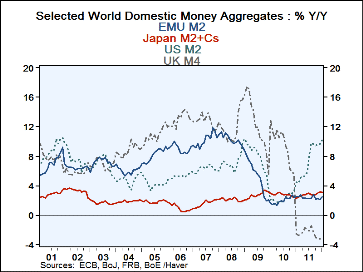 Global| Feb 27 2012
Global| Feb 27 2012Money Supplies: US Heats Up as UK Stays in Big Chill... As Growth Rates Flat-Line Elsewhere
Summary
Money growth continues to show some amazingly different international trends in the key developed countries of the global monetary center. In the US money growth has kicked up but velocity has shifted down, keeping that pick up at bay [...]
 Money growth continues to show some amazingly different international trends in the key developed countries
of the global monetary center. In the US money growth has kicked up but velocity has shifted down, keeping
that pick up at bay in terms of impacting economic growth.
Money growth continues to show some amazingly different international trends in the key developed countries
of the global monetary center. In the US money growth has kicked up but velocity has shifted down, keeping
that pick up at bay in terms of impacting economic growth.
In the UK where even more QE has been applied, money growth has gotten even more lethargic. In the UK M4 continues to decelerate and sharply. Its three-month rate of growth is down to nearly a -8% annual rate form -4% year-over-year.
In EMU real money balances are pretty flat; but credit growth expressed in real terms is still deteriorating.
US M2 growth is staying at about a 10% annual rate but real money balances are in a steady acceleration with the three-month growth rate up to 8%. As mentioned above in the US monetary velocity has shifted down and that is keeping monetary stimulus from taking hold. Still, the US economy is starting to stir even as growth has shifted down for EMU as a whole, as well as across nearly all EMU nations. As job growth and other US measures are showing some of their best results- and doing so together – this is injecting a new optimism into the recovery outlook. It is not yet injecting fear into the inflation outlook.
In Japan nominal and real money growth rates are highly similar and both show slight cooling trends. But the BoJ is pledging to get its price level up, a pledge that finally is impacting the yen exchange rate and sending the yen stronger against the dollar. This long overdue move is unwinding the crushing effect on the economy of the yen’s spurt higher after Japan weathered a series of economic disasters last year.
On balance it is hard to paint too bright a picture of the future based on monetary trends. Despite worries about central banks being overly accommodative and the potential for inflation risks (amid rising oil prices) there is little evidence of excess monetary fuel being pumped in. Sure interest rates are low and have been low for a long time but money growth STILL is not strong.
The US is the exception where 10% M2 growth does seem robust, but there velocity has shifted down blunting the impact on economic stimulus and on inflation. But as we know, velocity is fickle. For now it is shifting down in the US; will it shift back up and give the Fed something to worry about? If it does will the Fed do anything since it is missing the growth part of its mandate so badly? How much of its inflation progress would the Fed turn a blind eye to while arguing that it is still close enough to its professed 2% mark to allow it to not lean against rising inflation pressure and to let growth try to recover a bit more? Where would that trade off start and stop? The US seems to be the only place where such a worries have any chance of developing over the next six months given the trends in the table.
Resid
Crdt
Robert Brusca
AuthorMore in Author Profile »Robert A. Brusca is Chief Economist of Fact and Opinion Economics, a consulting firm he founded in Manhattan. He has been an economist on Wall Street for over 25 years. He has visited central banking and large institutional clients in over 30 countries in his career as an economist. Mr. Brusca was a Divisional Research Chief at the Federal Reserve Bank of NY (Chief of the International Financial markets Division), a Fed Watcher at Irving Trust and Chief Economist at Nikko Securities International. He is widely quoted and appears in various media. Mr. Brusca holds an MA and Ph.D. in economics from Michigan State University and a BA in Economics from the University of Michigan. His research pursues his strong interests in non aligned policy economics as well as international economics. FAO Economics’ research targets investors to assist them in making better investment decisions in stocks, bonds and in a variety of international assets. The company does not manage money and has no conflicts in giving economic advice.






